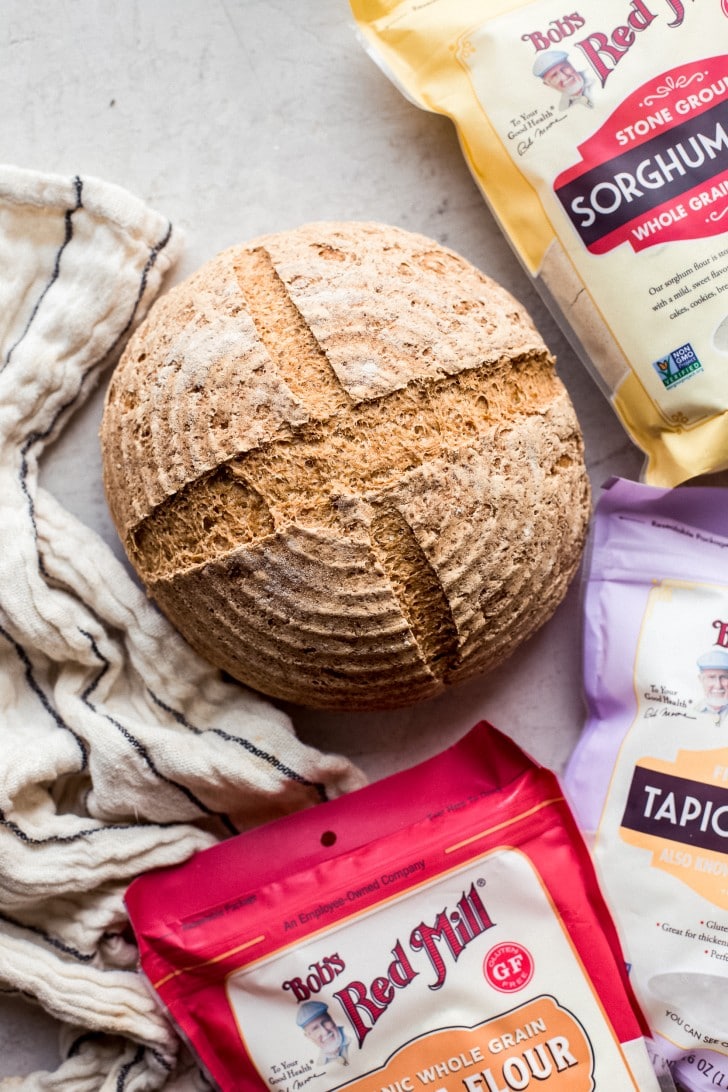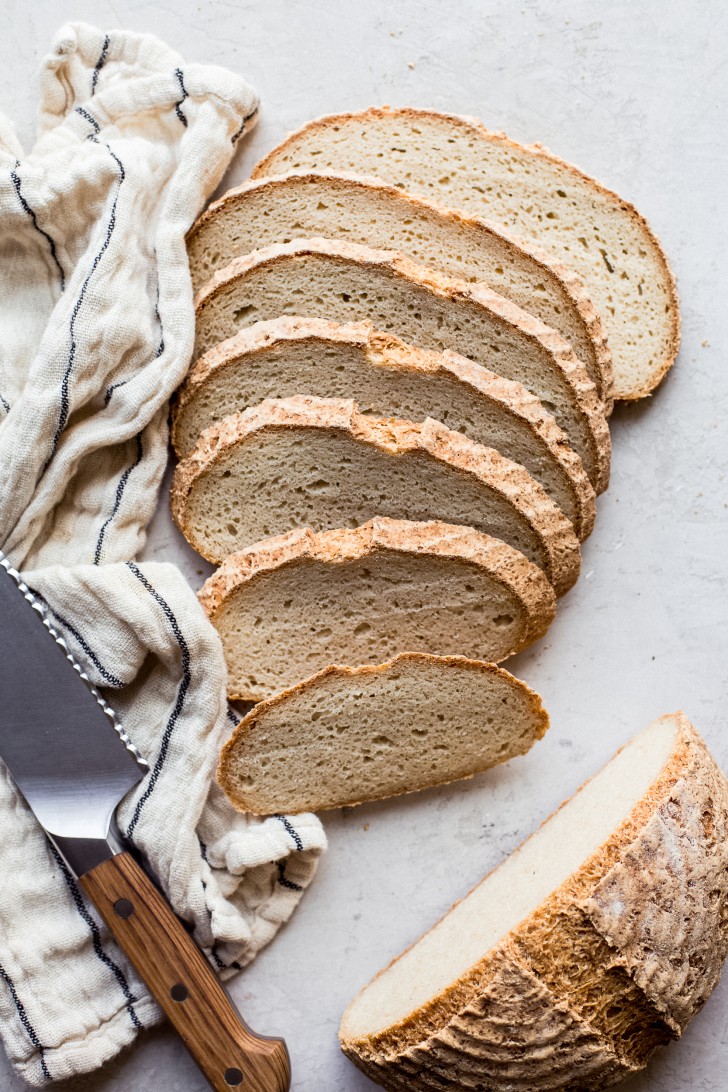A classic Gluten-Free Bread boule, made with yeast and ready in just a few hours! It’s light, fluffy, and perfect for sandwiches, toast, and anything else you’d use bread for. This gluten-free loaf is also vegan and free of the top 8 food allergens. Thanks to Bob’s Red Mill for sponsoring this post!
I’ve been deep in gluten-free sourdough land for a while now. It started with my classic gluten-free sourdough loaf, then extended into sourdough pizza, sourdough crackers, sourdough focaccia…until I was feeding my starters all the time and constantly making bread and its friends. I even started a gluten-free sourdough Facebook group, where we share tips and tricks and advice! It’s been a blast because sourdough is a deeeeep rabbit hole, and it’s fun to have friends down there with you!
But one thing I’ve been asked about a lot is how people can make amazing gluten-free bread without needing to maintain a sourdough starter. Not everyone has the patience to get one going or keep it maintained, and I totally get that. Sourdough is a process and it can take planning to get perfect loaves. So, it became clear we needed a traditional yeasted gluten-free bread!
…and I am OH SO happy to introduce you to her!!! This homemade gluten-free bread boule is a winner. She’s light and fluffy, with a nice crumb, NO gumminess that sometimes accompanies gluten-free bread, and the best part? You can have this bread DONE in about three and a half hours. Then you just have to deal with the hard part – waiting for it to cool! Now let’s get into the details.

What ingredients do you need to make gluten-free bread?
A note: I don’t share any volume measurements for this bread, because I find it’s so much easier and more accurate to use weight. Please get a baking scale if you’ll be doing bread baking with any kind of regularity – it will make things much easier and more accurate! Plus, less messy measuring cups 🙂
- Active Dry Yeast: this provides our lift for the recipe and gives us a nice, fluffy loaf!
- Maple Syrup , Honey, or Sugar: most of the sugar is actually “eaten” by the yeast and helps your bread rise – this won’t add any sweetness to the bread.
- Filtered Water: filtered or distilled is important! Hard water can inhibit the rise of your bread.
- Psyllium Husk: our magic ingredient! It helps replace the gluten and adds structure and elasticity to the loaf. More details on this ingredient below!
- Olive Oil: olive oil helps soften the crust and adds to the flavor.
- Potato Starch: make sure you seek out the white, powdery potato starch, not potato flour!
- Tapioca or Arrowroot Flour: interchangeable with tapioca or arrowroot starch, these add lightness and fluffiness to the bread.
- Sorghum Flour: this has a light, sweet, mild flavor that works incredibly well in this bread.
- Brown Rice Flour: more of a whole-grain kind of flour, but still lends for a light and fluffy bread loaf. Can be switched out with white rice flour, or another whole-grain flour if you’re avoiding rice.
- Quinoa Flour: I love the light fluffy texture quinoa flour brings to the table, but too much can add a slightly bitter taste, so I keep the amount on the smaller side.
- Sea Salt: for flavor, of course!

All of the yeast, flours, and starches that I use are from Bob’s Red Mill, one of my all-time favorite brands for all things flour and baking supplies! I love how many organic options they have, how widely available their products are, and that so many of their flours are certified gluten-free. I highly recommend their products for this recipe (and all of my recipes) for great results! They can be found in most grocery stores, as well as on Amazon and many other online retailers.
Can I switch the flours? Yes, you can switch and substitute the whole grain flours (brown rice, sorghum, and quinoa) for each other and for other whole grain flours (buckwheat, millet, white rice, teff, etc.) if you want to experiment. Each has its own properties and flavors, but it can be super fun to experiment here and see which combination makes for your favorite loaf.

How long does this gluten-free bread take to make?
One of my favorite things about this recipe is that it can be done in about two and a half hours, start to finish!! That is way quicker than sourdough, so this is a perfect last-minute bread recipe when you want some bread to eat that day! And of that three and a half hours, probably only about 30ish minutes (if even) is active time. The rest of it is rising and baking time!
How to Make the Best Gluten-free Bread | Easy Gluten-free Sandwich Bread Recipe
Are there breads without wheat or soy in them?
To help you out, here is a list of 49 breads without wheat or soy in them. Udi’s makes a phenomenal line of breads that do not contain any wheat or soy. They have a great taste and have ingredients like brown rice flour, sunflower oil, and egg whites. You can likely find these tasty bread options at your local Walmart.
Is it good to have wheat bread?
Yes, it is good to have wheat bread. Whole grains keep the entire grain intact, including the germ, endosperm and the bran. The bran is the harder outer layer which is high in fiber. Whole wheat is high in fiber and considered more nutritious than refined grains. Whole wheat have been linked to numerous health benefits, including a decrease risk of type 2 diabetes, heart disease and certain cancers. Whole wheat bread made from 100% whole wheat flour is higher in fiber, vitamins and minerals than breads made from refined wheat.
Should you eat less wheat bread?
There are various reasons why a person may wish to avoid or eat less wheat bread, such as if they have a reaction to gluten. There are many healthful wheat-free alternatives to choose from, such as rye bread, sourdough bread, and more.
Can you eat bread without problems?
Wheat is also high in short-chain carbs called FODMAPs, which cause digestive distress in many people. Although many people can still eat bread without problems, there are others who do best avoiding it. Fortunately, convenient and healthy alternatives to bread are becoming more readily available.
